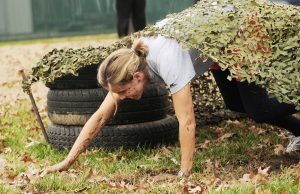
Are you looking to break the mold this time around with your child’s sport fundraiser? Make things fun for everyone involved and organize an obstacle course! This may seem like an insurmountable task at first. After a little brainstorming and planning however, you’ll find that with a couple motivated individuals, you can get the obstacle course off the ground and running, just like the course participants.
Similar to any fundraiser, there is a lot to consider and organize leading up to the event. The day itself will also require some work on the team’s part. Even though everyone involved will have a lot of work ahead of them, an obstacle course has the potential to be one of the most memorable fundraising experiences in team history. Who knows? If everything goes to plan, you can continue the tradition of an obstacle course every year.
Finding a location
First things first, you need a suitable location to house the obstacle course. The ideal spot would be either a field or park. Obstacle courses tend to take up a lot of space. Having it outside gives you plenty of room. You will have to be conscious of the weather though. Some alternatives to parks and fields include large gymnasiums or rec centers. Wherever you land on with the location, strive for something spacious. Small sites prohibit the number of obstacles you can include. It may also hurt your bottom line. A small area won’t be able to hold as many people. Less people means less money raised for the team.
Registration and waivers
Requiring people to register and fill out a waiver is paramount. The registration aids in keeping things organized. It’s up to the planners how they want to run the obstacle course. You can have competitors participate as individuals or in teams. Each will be exciting. If you’re looking for a more competitive fundraiser, a team obstacle course would be the way to go.
Waivers are equally as important. Your course may not be as intense as one at an Army boot camp, but there is still a risk of injury. Make it clear that every participant needs to sign a waiver before entering the course. Waivers shift the accountability from the team to the individual. Anyone under 18 can have a parent fill out the waiver for them. Creating waivers shouldn’t scare you away from the fundraising idea. It’s simply a precaution.
The easiest way to handle these documents is to create them in Google Forms. It’s a simple tool that does most of the work for you. All you have to do is enter the necessary information you’d like to include on the form: name, age, course team, etc. You can even include a link to PayPal or a similar service and collect registration fees digitally. If the team has a Facebook page or other social media accounts, you can post links to the forms on there.
Setting up the course

- Rope climbing
- Balance beam
- Wall climbing
- Mud pits
- Bag races
- Ball pit
- Tire pits
- Pools of soapy water
- Rope swing
- Cargo net climb
- Inflatables
There are tons more out there to consider. Look online for some inspiration. Coaches, physical education teachers, and fitness instructors might have some helpful suggestions for how to structure the obstacle course and what to include.
So, you settled on what obstacles to include, but how are you going to get them? Some can be built very easily. A quick trip to the hardware store can supply you with all of the materials you’ll need. Seek out places that have obstacles you want and explain why you need them. Many businesses are more than happy to help out with sports fundraisers. They might knock down the price! You can also use some of the registration money to purchase obstacles.
Another component you might want to include is checkpoints. These are rest areas located throughout the obstacle course. Station them with volunteers working the event. The volunteers can hand out water to parched participants. Having checkpoints is an efficient way to monitor the contestants and make sure everyone is okay.
Food, first-aid, and awards

As the waiver implies, an obstacle course does run a risk of injuries. Requiring competitors to sign one isn’t the only precautionary step you should take. Remember to keep a couple first aid kits on site. You don’t need an operating rooms worth of supplies, but definitely include the essentials. Gauze wrappings, band aids, tweezers, disposable gloves, cleansing wipes, surgical tape, and antiseptic cream should get the job done.
Chances are people are going to get competitive on the obstacle course. Fuel that competitive attitude with the promise of handing out awards after the fundraiser is over. You can purchase custom trophies for cheap on the internet. Here’s one example.
There aren’t many fundraising ideas as exciting as an obstacle course. It may be a lot of work, but it’ll pay off in the end when the team makes a lot of money.
